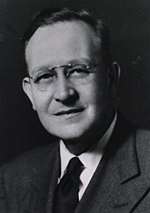Jay McLean
Jay McLean (1890 – November 14, 1957) was an American surgeon. He is most notable for his major contribution to the discovery of heparin.
Jay McLean | |
|---|---|
 | |
| Born | Philippines |
| Died | Savannah, Georgia, United States |
| Known for | Heparin |
| Medical career | |
| Profession | Physician |
Early life
Born in San Francisco in 1890, he was the son of a physician, John T. McLean. Following education at Lowell High School, he entered the University of California at Berkeley in 1909, obtaining his Bachelor of Science degree in 1914.[1]
Career
McLean entered Johns Hopkins School of Medicine in 1915 where he met and began work with physiologist William Henry Howell. In 1916, when McLean was a second-year medical student, he was investigating pro-coagulant compounds when he first isolated a fat-soluble phosphatide anti-coagulant.[2] This anti-coagulant was first isolated from the liver tissue of canines, which is how Heparin got its name(hepar or "ήπαρ" is Greek for "liver"; hepar + -in), first coined in 1918.[3] Following the departure of McLean, Howell continued his work and with the assistance of T. Emmett Holt he isolated a water-soluble polysaccharide anticoagulant.[4] Howell also coined 'heparin' as the name of this compound despite being different from the compound previously discovered by McLean.[5]
McLean graduated from Johns Hopkins in 1919 and began an internship at the Johns Hopkins Hospital.[4] Following completion of his internship, he began a surgical residency, in which he rotated through the Hunterian Laboratory, the laboratory founded by Harvey Cushing in 1904.[6]
McLean stayed in Baltimore until 1924 when returned to his alma-mater, the University of California to become an instructor in surgery.[4] After three years in California, McLean took a position in the Department of Pathology at Cornell University, a position which he held until 1939.[4] After leaving Cornell, McLean moved to Columbus, Ohio, where he worked in private surgical practice and was appointed as an associate professor of surgery at Ohio State medical school.[4] In 1949, he was appointed director of Radiation Therapy and Consultant in Malignant Diseases in Savannah, Georgia, where he remained until his death in 1957, aged 67 years.[4]
References
- MCLEAN, J. (1 January 1959). "The Discovery of Heparin". Circulation. 19 (1): 75–78. doi:10.1161/01.CIR.19.1.75. PMID 13619023.
- McLean J (1916). "The Thromboplastic Action of Cephalin". American Journal of Physiology.
- Mueller RL, Scheidt, S (1994). "History of drugs for thrombotic disease. Discovery, development, and directions for the future". Circulation. 89: 432–449. doi:10.1161/01.cir.89.1.432. PMID 8281678.CS1 maint: multiple names: authors list (link)
- Couch NP (1989). "About heparin, or ... whatever happened to Jay McLean?". J. Vasc. Surg. 10 (1): 1–8. doi:10.1016/0741-5214(89)90277-2. PMID 2664233.
- "ajplegacy.physiology.org".
- Sampath P, Long DM, Brem H (2000). "The Hunterian Neurosurgical Laboratory: the first 100 years of neurosurgical research". Neurosurgery. 46 (1): 184–94, discussion 194–5. doi:10.1093/neurosurgery/46.1.184. PMID 10626949.